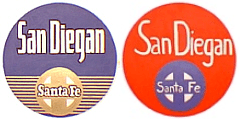First service March 27, 1938 | Last service June 1, 2000 | |
 | ||
Former operator(s) Atchison, Topeka and Santa Fe RailwayAmtrak | ||
The San Diegan was one of the named passenger trains of the Atchison, Topeka and Santa Fe Railway, and a “workhorse” of the railroad. Its 126-mile (203-kilometer) route ran from Los Angeles, California south to San Diego. It was assigned train Nos. 70–79 (Nos. 80–83 were added in 1952 when RDCs began operating on the line).
Contents
The Los Angeles-San Diego corridor (popularly known as the “Surf Line” — officially, the Fourth District of the Los Angeles Division) was to the Santa Fe as the New York City–Philadelphia corridor was to the Pennsylvania Railroad. Daily traffic could reach a density of ten trains (each way) during the summer months. The first San Diegan ran on March 27, 1938 as one set of equipment making two round trips a day.
A second trainset delivered in 1941 made possible four streamlined trains each way. A set of heavyweight equipment made a fifth trip in each direction. During and after the Second World War, furlough business from San Diego's military bases necessitated extra (albeit heavyweight) sections of San Diegans, and racetrack specials during horseracing season at Del Mar added to passenger train miles.
Amtrak continued to operate the San Diegan when it took over operation of the nation's passenger service on May 1, 1971, and it retired the name on June 1, 2000. Today, the route of the San Diegan (the second busiest passenger rail line in the United States) is served by Amtrak's Pacific Surfliner.
Background
Construction of the Surf Line between Los Angeles and San Diego began on October 12, 1880, with the organization of the California Southern Railroad Company. On January 2, 1882, the California Southern commenced passenger and freight service between National City and Fallbrook Junction, just north of Oceanside. The Santa Fe assumed control of the California Southern and on August 12, 1888, completed the line between Los Angeles and San Diego. Initially known as the "Short Line", the route replaced the Santa Fe's existing circuitous route via Temecula Canyon. In the 1930s the Surf Line hosted four round-trips per day, with an average trip time of 3 1⁄2 hours.
San Diegan
In the late 1930s streamlined trains were in transition. While fixed consists such as the Union Pacific Railroad's M-10000 were out (the last, the Illinois Central 121, had been built in 1936), railroads still ordered sets of equipment with the intention that those sets stay with a particular train. In 1937–1938 the Santa Fe embarked on a massive program to upgrade its passenger fleet, introducing new sets on the Super Chief, Chief, and El Capitan; and three new trains: the Chicagoan, Kansas Cityan, and the San Diegan.
On March 27, 1938, the Santa Fe inaugurated the San Diegan, operating on a schedule of 2 1⁄2 hours. The single equipment set could make two round-trips per day. A second San Diegan consist entered service on June 8, 1941, doubling the schedule to four daily round trips. The San Diegan was supplemented by two conventional heavyweight trains.
Amtrak
Amtrak assumed control of most intercity passenger trains in the United States of May 1, 1971. It retained two of the San Diegan's three round-trips. Between November 1971–April 1972 the long-distance Coast Daylight/Coast Starlight operated between Los Angeles and San Diego; in April this practice ended, replaced by a third San Diegan Beginning in 1976 the state of California funded additional service: a fourth round-trip on September 1, 1976 a fifth on April 24, 1977, and a sixth on February 14, 1978. On October 26, 1980 Amtrak added yet another round-trip, increasing daily service to seven round-trips. Between April 29, 1984 and April 28, 1985 Amtrak experimented with an express service between Los Angeles and San Diego. This was targeted at business customers and made fewer stops than the regular San Diegan trains. Dubbed Metroliner after the high-speed service on the Northeast Corridor, it was unpopular and suffered from low ridership. After its discontinuance Amtrak restored the seventh San Diegan and introduced Custom class on the route.
Equipment used
The original San Diegan consist included a baggage car, two coaches (60 seats each), a lunch counter-tavern car, and a parlor-observation car. Motive power consisted of a single 1,800 hp (1,300 kW) EMC E1A locomotive sporting the familiar Warbonnet paint scheme. These units would, in time, be replaced by ALCO PA and PB power and EMD F3 and F7 locomotives. Santa Fe's lone trio of Fairbanks-Morse (FM) "Erie-built" locomotives and the odd GE U28CG could also be seen occasionally running the line.
A lone pair of 90-seat self-powered Budd Rail Diesel Cars (RDCs) were acquired for express service. They operated "back-to-back" as a single train unit from May 21, 1952 until the Redondo Junction derailment on January 22, 1956.
Three additional coach units were added for weekend traffic. The San Diegan also enjoyed almost exclusive use of Santa Fe's "pendulum-suspension" chair car, No. 1100, after World War II.
In June 1941, the railroad added a second eight-car trainset, also built by Budd, to handle the high demand. Its original consist was similar to the above save for an additional coach. Subsequent consists varied according to traffic levels.
A representative, all-lightweight consist from the Summer of 1955:
Under Amtrak ex-Santa Fe Hi-Level coaches were used in the early 1970s. Modern Amfleet coaches arrived in 1976. For a six-month period in 1978 service on the route was supplemented by the El Camino cars owned by Los Angeles County.
